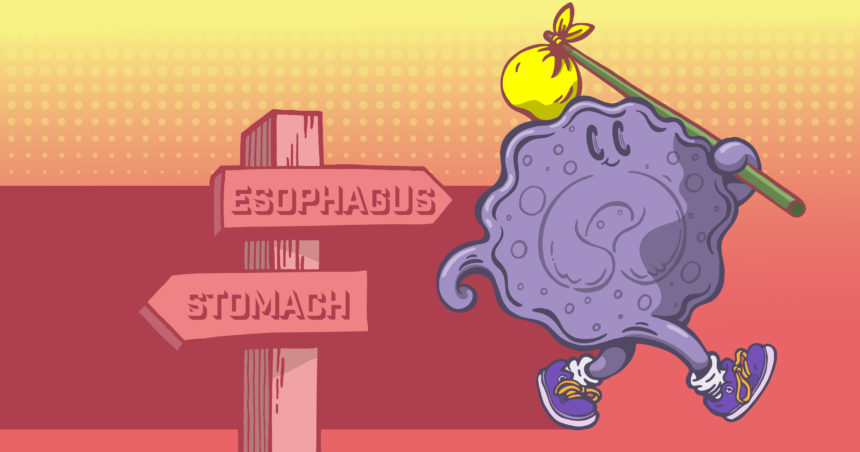The most common cause of food impaction is eosinophilic esophagitis—an allergic condition that only became prevalent in recent years.
“The disease was first described in the late 1970s, but it was very rare,” says Evan Dellon, MD, MPH, a gastroenterologist with UNC Health Care. “It was not commonly seen until the mid- to late 2000s. Now it’s becoming quite increased, and it’s not just increased awareness or knowledge of the condition. It really didn’t exist even 30 years ago.”
What Is Eosinophilic Esophagitis (EoE)?
EoE is an allergic condition of the esophagus in which eosinophils infiltrate the esophagus.
“In the GI tract, eosinophils are normally seen in the stomach, small intestine or the colon, but they are never supposed to be seen in the esophagus,” Dr. Dellon says. A patient with EoE will have a high concentration of eosinophils in the esophagus. Researchers are trying to determine why these cells move to the esophagus.
“Eosinophils cause irritation and swelling of the esophagus, and a number of chemicals inside the eosinophils that are released are pro-inflammatory,” Dr. Dellon says. “We think that this inflammatory reaction eventually starts causing scar tissue.” Over time, the buildup of scar tissue can cause strictures in the esophagus.
EoE Symptoms by Age Group
EoE can affect anyone at any age, but the symptoms manifest differently across age groups.
Adults and adolescents might experience:
- Trouble swallowing, food sticking or food going down slowly (dysphagia)
- Food impaction
Elementary-age children might experience:
- Abdominal pain
- Vomiting
- Heartburn
- Growth problems
- Food refusal
Toddlers might experience:
- Abdominal pain
- Vomiting
- Growth problems
- Feeding problems
Infants might experience:
- Feeding problems
- Vomiting
- Growth problems
The Rise of EoE
Researchers don’t have a clear indication of why EoE is more prevalent now than in recent years.
“Part of the increase in cases is due to the fact that it’s an allergic condition. All allergic conditions are increasing,” Dr. Dellon says. “There is also a thought that it falls into the hygiene hypothesis, where people are growing up in too clean of an environment, so the immune system doesn’t know how to react to things that might be normal exposures.”
Dr. Dellon says changes in the environment, food supply and medicines over the past 40 years might also play a role. “There are lots of different theories, but nobody really knows why it’s increasing so much,” he says.
What’s the Difference Between EoE and Food Allergies?
Although EoE is an immune response that can be triggered by certain foods, the initial cause of the allergic reaction is not known.
“We usually think of allergic reactions as immediate. You eat a peanut, you go into shock, and your throat closes up,” Dr. Dellon says. “EoE is not an immediate reaction like that. It may be that someone eats a piece of steak and it gets stuck, so they have to go to the emergency room to get it out, but it’s not usually an allergic reaction to that steak.”
Instead, patients with EoE will experience a delayed reaction. “It’s not totally clear how that allergic reaction starts, but it’s probably a chronic exposure to some foods or to something in the environment,” he says.
Besides environmental factors, researchers have discovered that certain genes might play a role in the development of EoE, but there does not appear to be a single gene that causes this disease.
Because the condition is categorized by a slow onset, people usually don’t know they are having a reaction until the symptoms are readily noticeable. This could cause some patients to have allergic inflammation for months or, in many cases, even years before seeking help.
How Do You Treat EoE?
Several treatment options are available for EoE, including:
Proton pump inhibitor (PPI) antacid medications.
“PPI medications have an anti-inflammation and anti-eosinophil effect that’s newly recognized,” Dr. Dellon says. “The medication blocks some of the allergic factors that cause EoE, and about 40 percent of patients will get better from just a PPI.”
However, PPI medications won’t work for all patients, and over-the-counter products are not sufficient. “This has to be prescription-strength and done under the guidance of a GI doctor with endoscopic evaluation and follow-up,” he says.
Topical steroid medications.
There are no FDA-approved medications for EoE. However, steroid medications used specifically for asthma can be adapted to treat EoE. Rather than breathing them in, patients swallow the medicine, which helps coat the esophagus and get rid of the eosinophils.
Dietary elimination.
If food triggers are causing a patient’s EoE, the most common treatment is an empirical elimination diet.
“We know through clinical practice and multiple studies that the most common triggers of EoE are dairy, wheat, egg, soy, and less commonly nuts and seafood,” Dr. Dellon says. “So you could do an empiric four-food or six-food elimination diet, but again this has to be done under the guidance of a GI doctor with endoscopic evaluation and follow-up, and often with the assistance of a dietitian or nutritionist.”
Endoscopic dilation.
“If people do have strictures and scar tissue from long-term EoE, we have to do an endoscopic dilation to stretch the esophagus,” Dr. Dellon says. “We usually couple the dilation with anti-inflammatory treatment to eliminate the eosinophils.”
Need to refer a patient? Learn more about the Center for Esophageal Diseases and Swallowing and other gastroenterology and hepatology services offered at UNC Medical Center and UNC REX Healthcare.

